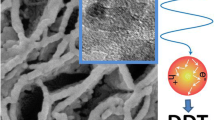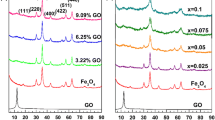Abstract
A heterogeneous Fenton catalyst Ce0–Fe0-reduced graphene oxide (Ce–Fe–RGO) was synthesized with chemical reduction methods and used for degradation of sulfamethazine. The introduction of Ce and graphene increased the dispersibility of iron particles which was confirmed by SEM and TEM. The results of VSM analysis showed good magnetism of Ce–Fe–RGO. The catalyst performance was compared with other kinds of catalysts (Fe0 and Ce0–Fe0) for degradation of sulfamethazine. The results showed that Ce0–Fe–RGO had good catalytic performance and adsorption. X-ray diffraction showed the change of iron oxide on catalyst surface after use. The total sulfur (TS), total nitrogen (TN), total organic carbon (TOC), and intermediates, such as small organic molecular and anion ions, were analyzed by IC under different pH conditions. Finally, the possible catalytic mechanism was tentatively proposed based on inhibitor experimental results and XPS characterization. The main active species was hydroxyl radical on catalyst surface and the transition between Ce3+ and Ce4+ which enhanced the reduction from Fe3+ to Fe2+ and formation of ·OH and ·O2 −.









Similar content being viewed by others
References
Allen MJ, Tung VC, Kaner RB (2009) Honeycomb carbon: a review of graphene. Chem Rev 110(1):132–145
Aneggi E, Cabbai V, Trovarelli A, Goi D (2012) Potential of ceria-based catalysts for the oxidation of landfill leachate by heterogeneous Fenton process. Int J Photoenergy 2012:1–8
Beltran FJ, Aguinaco A, García-Araya JF, Oropesa A (2008) Ozone and photocatalytic processes to remove the antibiotic sulfamethoxazole from water. Water Res 42(14):3799–3808
Bielski BH, Cabelli DE, Arudi RL, Ross AB (1985) Reactivity of HO2/O2 − radicals in aqueous solution. J Phys Chem Ref Data 14(4):1041–1100
Burroughs P, Hamnett A, Orchard AF, Thornton G (1976) Satellite structure in the X-ray photoelectron spectra of some binary and mixed oxides of lanthanum and cerium. J Chem Soc Dalton Trans 17:1686–1698
Buxton GV, Greenstock CL, Helman WP, Ross AB (1988) Critical review of rate constants for reactions of hydrated electrons, hydrogen atoms and hydroxyl radicals (⋅OH/⋅O−) in aqueous solution. J Phys Chem 17(2):513–886
Choi Y, Bae HS, Seo E, Jang S, Park KH, Kim B (2011) Hybrid gold nanoparticle-reduced graphene oxide nanosheets as active catalysts for highly efficient reduction of nitroarenes. J Mater Chem 21(39):15431–15436
Danilczuk M, Schlick S, Coms FD (2009) Cerium (III) as a stabilizer of perfluorinated membranes used in fuel cells: in situ detection of early events in the ESR resonator. Macromolecules 42(22):8943–8949
Deeb O, Hemmateenejad B, Jaber A, Garduno-Juarez R, Miri R (2007) Effect of the electronic and physicochemical parameters on the carcinogenesis activity of some sulfa drugs using QSAR analysis based on genetic-MLR and genetic-PLS. Chemosphere 67(11):2122–2130
Dirany A, Sirés I, Oturan N, Oturan MA (2010) Electrochemical abatement of the antibiotic sulfamethoxazole from water. Chemosphere 81(5):594–602
Elliot AJ (1992) A pulse radiolysis study of the reaction of ·OH with I2 and the decay of I2. Can J Chem 70(6):1658–1661
Geim AK (2009) Graphene: status and prospects. Science 324(5934):1530–1534
Ghandi HS, Piken AG, Shelef M, Deloch RG (1976) Automotive engineering congress and exposition, Detroit, MI. SAE Paper 760201
Gubler L, Koppenol WH (2011) Kinetic simulation of the chemical stabilization mechanism in fuel cell membranes us using cerium and manganese redox couples. J Electrochem Soc 159(2):B211–B218
Heckert EG, Seal S, Self WT (2008) Fenton-like reaction catalyzed by the rare earth inner transition metal cerium. Environ Sci Technol 42(13):5014–5019
Hu XB, Liu BZ, Deng YH, Chen HZ, Luo S, Sun C, Yang P, Yang SG (2011) Adsorption and heterogeneous Fenton degradation of 17α-methyltestosterone on nano Fe3O4/MWCNTs in aqueous solution. Appl Catal B Environ 107(3):274–283
Jabeen H, Chandra V, Jung S, Lee JW, Kim KS, Kim SB (2011) Enhanced Cr (VI) removal using iron nanoparticle decorated graphene. Nanoscale 3(9):3583–3585
Keenan CR, Sedlak DL (2008) Factors affecting the yield of oxidants from the reaction of nanoparticulate zero-valent iron and oxygen. Environ Sci Technol 42(4):1262–1267
Kushwaha S, Sreedhar B, Padmaja P (2012) XPS, EXAFS, and FTIR as tools to probe the unexpected adsorption-coupled reduction of U (VI) to U (V) and U (IV) on borassus flabellifer-based adsorbents. Langmuir 28(46):16038–16048
Li HL, Wu CY, Li Y, Zhang JY (2011) CeO2-TiO2 catalysts for catalytic oxidation of elemental mercury in low-rank coal combustion flue gas. Environ Sci Technol 45(17):7394–7400
Li Y, Zhang FF, Liang XM, Yediler A (2013) Chemical and toxicological evaluation of an emerging pollutant (enrofloxacin) by catalytic wet air oxidation and ozonation in aqueous solution. Chemosphere 90(2):284–291
Li ZJ, Deng SB, Yu G, Huang J, Lim VC (2010) As (V) and As (III) removal from water by a Ce-Ti oxide adsorbent: behavior and mechanism. Chem Eng J 161(1):106–113
Ling Q, Yang M, Li CS, Zhang AM (2014) Preparation of highly dispersed Ce-Fe bimetallic oxides on graphene and their superior adsorption ability for Congo red. RSC Adv 4(8):4020–4027
Mansour AN, Melendres CA (1995) A study of the structure and the morphology of oxide films on amorphous al Fe-Ce alloys by XPS and SEM. J Electrochem Soc 142(6):1961–1968
Mansour D, Fourcade F, Soutrel I, Hauchard D, Bellakhal N, Amrane A (2015) Relevance of a combined process coupling electro-Fenton and biological treatment for the remediation of sulfamethazine solutions—application to an industrial pharmaceutical effluent. C R Chim 18(1):39–44
Martins RC, Dantas RF, Sans C, Esplugas S, Quinta-Ferreira RM (2015) Ozone/H2O2 performance on the degradation of sulfamethoxazole. Ozone Sci Eng 37(6):509–517
Ni YH, Ge XW, Zhang ZC, Ye Q (2002) Fabrication and characterization of the plate-shaped γ-Fe2O3 nanocrystals. Chemosphere 14(3):1048–1052
Pignatello JJ, Liu D, Huston P (1999) Evidence for an additional oxidant in the photoassisted Fenton reaction. Environ Sci Technol 33(11):1832–1839
Rahn RO (1997) Potassium iodide as a chemical actinometer for 254 nm radiation: use of iodate as an electron scavenger. Photochem Photobiol 66(6):885
Ryu A, Jeong SW, Jang A, Choi H, Appl (2011) Reduction of highly concentrated nitrate using nanoscale zero-valent iron: effects of aggregation and catalyst on reactivity. Appl Catal B Environ 105(1):128–135
Sánchez-Polo M, López-Peñalver J, Prados-Joya G, Ferro-Garcia MA, Rivera-Utrilla J (2009) Gamma irradiation of pharmaceutical compounds, nitroimidazoles, as a new alternative for water treatment. Water Res 43(16):4028–4036
Santos MLP, Bagatin IA, Pereira EM, Ferreira AMDC (2001) Redox behaviour and reactivity of some di-Schiff base copper (II) complexes towards reduced oxygen species. J Chem Soc Dalton Trans doi: 10.1039/B004985l
Stankovich S, Dikin DA, Piner RD, Kohlhaas KA, Kleinhammes A, Jia Y, Wu Y, Nguyen ST, Ruoff RS (2007) Synthesis of graphene-based nanosheets via chemical reduction of exfoliated graphite oxide. Carbon 45(7):1558–1565
Trovó AG, Nogueira RF, Agüera A, Fernandez-Alba AR, Sirtori C, Malato S (2009) Degradation of sulfamethoxazole in water by solar photo-Fenton. Chemical and toxicological evaluation. Water Res 43(16):3922–3931
Xiong Z, Zhang LL, Zhao XS (2011) Visible-light-induced dye degradation over copper-modified reduced graphene oxide. Chem-Eur J 17(8):2428–2434
Xu LJ, Wang JL (2013) Degradation of chlorophenols using a novel Fe0/CeO2 composite. Appl Catal B Environ 142:396–405
Yan WL, Herzing AA, Li XQ, Kiely CJ, Zhang WX (2010) Structural evolution of Pd-doped nanoscale zero-valent iron (nZVI) in aqueous media and implications for particle aging and reactivity. Environ Sci Technol 44(11):4288-429
Yang B, Tian Z, Zhang L, Guo YP, Yan SQ (2015) Enhanced heterogeneous Fenton degradation of methylene blue by nanoscale zero valent iron (nZVI) assembled on magnetic Fe3O4/reduced graphene oxide. J Water Process Eng 5:101–111
Yang SX, Zhu WP, Jiang ZP, Chen ZX, Wang JB (2006) The surface properties and the activities in catalytic wet air oxidation over CeO2-TiO2 catalysts. Appl Surf Sci 252(24):8499–8505
Zha SX, Cheng Y, Gao Y, Chen ZL, Megharaj M, Naidu R (2014) Nanoscale zero-valent iron as a catalyst for heterogeneous Fenton oxidation of amoxicillin. Chem Eng J 255:141–148
Zhang Y, Yang M, Dou XM, He H, Wang DS (2005) Arsenate adsorption on an Fe-Ce bimetal oxide adsorbent: role of surface properties. Environ Sci Technol 39(18):7246–7253
Zhang YP, Jia CG, Peng R, Ma F, Ou GN (2014) Heterogeneous photo-assisted Fenton catalytic removal of tetracycline using Fe-Ce pillared bentonite. J Cent South Univ 21:310–316
Zubir NA, Yacou C, Motuzas J, Zhang XW, Da Costa JCD (2014) Structural and functional investigation of graphene oxide-Fe3O4 nanocomposites for the heterogeneous Fenton-like reaction. Sci Rep-UK 4
Acknowledgments
The research was supported by the National Natural Science Foundation of China (Grant No. 51338005) and the Program for Changjiang Scholars and Innovative Research Team in University (IRT-13026).
Author information
Authors and Affiliations
Corresponding author
Additional information
Responsible editor: Santiago V. Luis
Rights and permissions
About this article
Cite this article
Wan, Z., Wang, J. Ce-Fe-reduced graphene oxide nanocomposite as an efficient catalyst for sulfamethazine degradation in aqueous solution. Environ Sci Pollut Res 23, 18542–18551 (2016). https://doi.org/10.1007/s11356-016-7051-0
Received:
Accepted:
Published:
Issue Date:
DOI: https://doi.org/10.1007/s11356-016-7051-0




